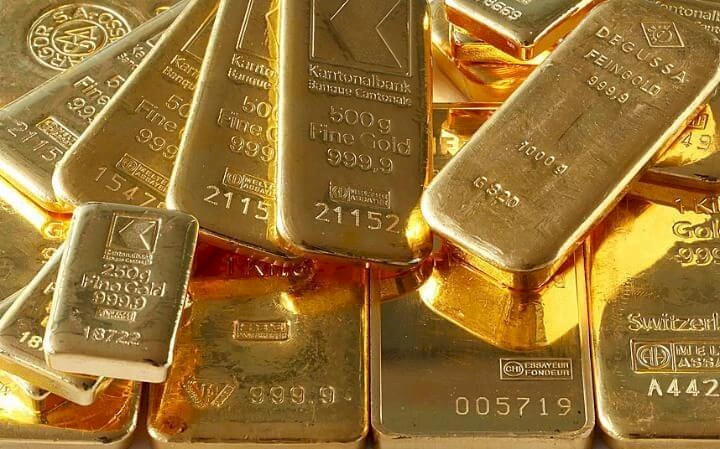
For the First Time.. The Ounce Exceeds $4000
SadaNews - The prices of spot gold have risen above the level of $4,000 per ounce for the first time, as fears regarding the U.S. economy escalate and the government shutdown continues, adding new momentum to the strong rise of the precious metal.
Gold increased by 0.4% to reach $4,001.11 per ounce on Wednesday, marking a historic moment for the metal which traded below $2,000 just two years ago, achieving returns that have now outperformed stocks in this century.
Gold has jumped more than 50% this year amid uncertainty surrounding global trade, the independence of the Federal Reserve, and the stability of financial conditions in the United States. At the same time, geopolitical tensions have increased demand for safe assets, while central banks continue to buy gold at a high pace.
A Tool for Hedging Against Shocks
The rise in gold prices has gained further momentum as investors seek to hedge against potential shocks in the markets, following the government financing crisis in Washington.
Additionally, the start of the Federal Reserve's monetary easing cycle has been a supporting factor for gold, which does not pay interest. Investors reacted by injecting their funds into exchange-traded funds, with gold-backed funds experiencing the largest monthly inflow in over three years in September.
Charu Chanana, a strategic analyst at "Saxo Capital Markets Pte," noted that "gold breaking the $4,000 level is not just about fear, but about asset reallocation." She added: "With the halt in economic data releases and the approach of interest rate cuts, real yields are declining, while AI company stocks seem overvalued. Central banks have laid the foundation for this upward wave, but individual investors and exchange-traded funds are now leading the next phase."
Gold Reflects Global Economic and Political Crises
Typically, spikes in gold prices coincide with periods of significant economic and political pressures. The metal breached the $1,000 mark per ounce following the global financial crisis, $2,000 during the COVID pandemic, and $3,000 in March when Trump's tariff plans impacted global markets.
Today, gold has surpassed the $4,000 barrier amid a landscape dominated by U.S. President Donald Trump's confrontation with the Federal Reserve, including threats to its Chairman Jerome Powell and efforts to dismiss Governor Lisa Cook, marking the clearest test yet of the independence of the U.S. central bank.
A leniency from the Federal Reserve, which could lower interest rates and stimulate inflation, may create an ideal situation for gold that does not yield returns. Gold is traditionally seen as a hedge against inflation and its attractiveness often diminishes when borrowing costs rise, making cash and bonds more appealing.
Analysts at "Macquarie Bank Limited" noted in a memo dated September 30: "We expect gold to reach its cyclical peak when concerns about the independence of the Federal Reserve reach their height," adding, "If the politically pressured Fed makes clear policy errors, gold's performance will undoubtedly be stronger."
Best Annual Performance Since the 1970s
Gold is on track to achieve its best annual performance since the 1970s, a period marked by high inflation and the end of the dollar's convertibility to gold, leading to a fifteenfold increase in the precious metal's price.
During that time, President Richard Nixon pressured the Fed to lower interest rates, while the central bank under Arthur Burns "made limited efforts" to maintain its independence, allowing inflation to worsen for political reasons, according to a recent court affidavit presented by several prominent monetary policy experts.
Stephen Miller, an investment advisor at "GSFM," stated that "the reason investors are buying gold, even feeling compelled to do so, is its portfolio diversification properties."
He added that this trend is still in its early stages, predicting that gold acceptance as a core element of sound investment behavior will increase, with prices likely reaching $4,500 by mid-next year.
Central Banks Driving the Gold Bull Market
Central banks have been the main driver behind the gold price surge, shifting from net sellers to net buyers following the global financial crisis. The pace of buying doubled after the U.S. and its allies froze Russia's foreign exchange reserves in 2022 following the war in Ukraine, prompting many central banks to diversify their reserves. Additionally, inflation and concerns about the U.S. government's less favorable treatment of foreign creditors have enhanced gold's attractiveness to policymakers.
Lina Thomas, a strategic commodities analyst at "Goldman Sachs Group Inc," described this trend in her September memo as a "structural shift in reserves management behavior," adding: "We do not expect a near-term reversal of this trend," confirming that the bank's baseline scenario assumes continued accumulation of gold by the official sector for three more years.

الشركات السعودية تعيد هيكلة إنفاقها وسط استمرار الزخم الاستثماري

China Continues to Lead the Global Scene in Base Metals

Global Coffee Prices Fall After Trump Cancels Tariffs on Brazil

Syria Officially Returns to the SWIFT System

Egypt buys 80 LNG shipments from US 'Hartree Partners' for 4 billion dollars

Gold price heading for slight weekly loss as interest rate cut chances fade

Slight Decline in Gold Prices with Rising Dollar
